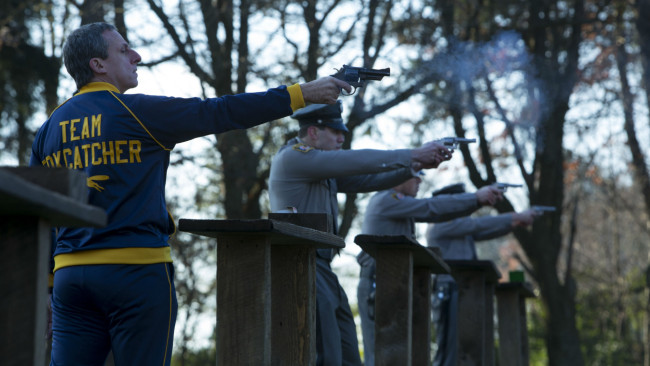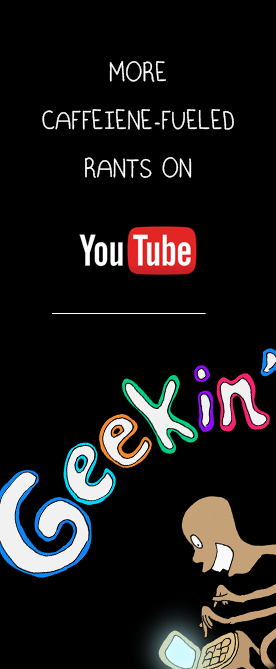Good rule of thumb: treat your shots like three-act stories. I first heard this while sieving through extra features on Criterion’s copy of Dino Risi’s Il Sorpasso. Alexander Payne (Sideways, Nebraska)—a director just-as obsessed with road-bound dramas that pit together characters whose philosophies clash and grate in amusing ways—introduced the Italian classic by sharing a lesson imparted to him by one of his professors: “When I studied this film before shooting Sideways, I’m looking very concretely at the shots. And Risi hasmany beautiful shots, which have—as I was taught in film school—beginnings, middles, and ends.”
Beginnings, middles, and ends.
As much as I love Payne and Risi this essay isn’t about them. They’re both skilled filmmakers—we’re all aware of that—but it’s Bennett Miller and his excellent Foxcatcher that’s under the lens today—and not the whole film either. It’s a great film, dark and ominous, immorally funny, and yet, several blessed inches away from dropping off the precipice of over-the-topness; it’s a film that’s more about the “sum of its parts”, rather than the “whole”. Which, conveniently enough, makes it a perfect candidate for helping me scrutinize Payne’s thoughts on three-act shots.
More than anything, more than abiding by the old three-act formula, which more and more movies are shrugging off for more “organic” storytelling—like Cassavettes and Altman did before—each and every shot needs to tell its own story.
Foxcatcher is full of these kinds of shots.
But lets talk about one specifically. Take a look below:
Let’s start with some context: In the scene prior to this, Mark (Channing Tatum) has finally introduced his creepy-crawly billionaire “coach” John DuPont (Steve Carrell) to his brother David (Mark Ruffalo) and David’s wife and kids. Caught up in the whirlwind of family life, Dave and his wife receive John with sapped enthusiasm, welcoming him with a tepid “hello” and “how are you?”. John isn’t accustomed to such low-voltage greetings, and so he sticks his nose up and leaves. This sets Mark off. With Big Boy injustice grilling his face red with shame, Mark vents and rants and barbs nonsensically at Dave and his wife: “You don’t even know what you don’t know.” Fed up with Mark’s bullshit, Dave’s wife kicks him out of her family’s hotel room and sends Dave out after him to sort it out.
CUT TO:
The shot: a profile in flat medium: Dave catches up with Mark in the hallway. Dave doesn’t bother bringing up John’s long-nosed snottiness, nor Mark’s hissy fit; instead—as he tends to do—he bears it. He loads it up on his gargoyled shoulders and continues the life long burden of carrying his brother’s baggage. Dave immediately launches into his coaching routine, right there in the middle of the hotel hallway; he shows Mark—directs him, advises him, fathers him—how to strategically approach his next opponent. This is how the Brothers Schultz communicate, this is how they apologize and bury the hatchet: they touch, they grapple, they sink their fingers into each others meat.
That gushy, intimate stuff.
This is nothing new for the movie. Miller sets their dynamic early on. The first time you see the brothers interact isn’t through dialogue, but with a training session on the mat. You hear the slap of skin, the heaving breath, the frustrated grunts. They speak through touch, especially Mark who’s tragically internal and aware of his inability to verbally communicate his shortcomings—like standing in a doorless room no bigger than your body, no space to breathe, no space to move, all that’s left are the unheard howls of frustrated flesh.
Here, too, in the hallway, neither Dave nor Mark openly apologize for their behavior: Dave for his neglect, and Mark for his petulant fit. Instead, they go for the grapple.
What’s most interesting about this shot—and most of the shots in the film—is Miller and Director of Photography Greig Fraser’s use of shallow focus. All of the focus in the above shot is on the two wrestlers. Everything behind them, around them, is blurred out. This is their world, their own private drama. No one else exists. Not even the couple behind them down the hall. They’re there, sure, but they’re blurred out due to Mark and Dave’s intense concentration. This is a bubble that isn’t so easily popped, not by the hotel couple, nor DuPont himself. As the movie progresses you see that there are more and more barriers between DuPont and his prized wrestlers, his champion bred “pets”, his foxcatchers. The barriers are sometimes literal, like the window and door blocking John from seeing an overweight Mark on his stationary bike working off “extra” fat in order to qualify for the next round; and sometimes they’re more figurative, like the soft-focused blur that divvies John from the brothers during their training sessions.
This is certainly a duh! kind of statement to make, but I still have to make it: there’s nothing more intimate than touch, and Miller seems to get that. Whenever there’s touch involved, he either isolates the touch—or the people reponsible for said touch—with shallow focus, or he cuts right in with an unrelenting close up. These men are simultaneously repulsed by touch and hungry for it; there’s no escaping neither it’s brutality nor tenderness. Touch can be supple, like the loving hug between two brothers, or aggressive and invasive like when DuPont “wrestles” Mark late at night.
What’s taken me roughly a thousand words to unpack, Miller conveys in a ten-second shot. Through framing, blocking, and focus, Miller acknowledges that the world continues spinning despite everyone’s best efforts—hence the out-of-focus couple in the background—that everything keeps moving and keeps growing despite alienating mansions, international competitions, and grand fortunes. Other people still exist; it’s only a matter of noticing.








